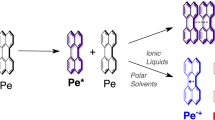Abstract
We used known experimental data to analyze the influence of intermolecular interactions on the position of the 0-0-band a1Δg → X3Σ −g phosphorescence of molecular oxygen in solutions. A bathochromic (red) shift caused by dispersion interactions and fluctuations of the internal electric field (induction effect) is analyzed employing new formulas obtained by us in the framework of the Onsager model. The contributions from intermolecular repulsion and higher multipole interactions to the shift of the spectrum are also discussed. It is found that the polarizability in the a1Δg state is higher than in the X3Σ t-g state by 0.19 ± 0.03 Å3. Taking into account the induced nature of O2 phosphorescence in solutions, it is noted that the change of polarizability Δαeg = 0.19 Å3 should differ from the change of Δαeg inherent in free molecular oxygen.
Similar content being viewed by others
References
R. Schmidt and H. D. Brauer, J. Am. Chem. Soc., 109, 6976–6980 (1987).
A. Bromberg and C. S. Foote, J. Phys. Chem., 93, 3968–3969 (1989).
I. M. Byteva, G. P. Gurinovich, A. P. Losev, and A. V. Mudryi, Opt. Spektrosk., 68, 545–548 (1990).
A. N. Macpherson, T. G. Truscott, and P. H. Turner, J. Chem. Soc., Faraday Trans., 90, 1065–1072 (1994).
J. M. Wessels and M. A. J. Rodgers, J. Phys. Chem., 99, 17,586–17,592 (1995).
R. Schmidt, J. Phys. Chem., 100, 8049–8052 (1996).
T. D. Poulsen, P. R. Ogilby, and K. V. Mikkelsen, J. Phys. Chem., 102, 8970–8973 (1998).
T. D. Poulsen, P. R. Ogilby, and K. V. Mikkelsen, J. Phys. Chem., 103, 3418–3422 (1999).
F. London, Trans. Faraday Soc., 33, 8–26 (1937).
K.-P. Huber and G. Herzberg, Molecular Spectra and Molecular Structure, 4: constants of Diatomic Molecules, Van Nostrand Reinhold, New York (1979).
A. Bondi, J. Phys. Chem., 68, 441–451 (1964).
Ya. I. Frenkel’, Collection of Selected Works. Vol. 3. Kinetic Theory of Liquids [in Russian], Izdat. Akad. Nauk SSSR, Moscow-Leningrad (1959), Chap. 4.
L. Onsager, J. Am. Chem. Soc., 58, 1486–1493 (1936).
P. Suppan, J. Photochem. Photobiol. A: Chem., 50, 293–330 (1990).
V. S. Pavlovich, Zh. Prikl. Spektrosk., 74, 162–168 (2007).
V. S. Pavlovich, Dokl. Akad. Navuk BSSR, 31, 412–415 (1987).
V. S. Pavlovich, Vestsi Akad. Navuk BSSR, Ser. Fiz.-Mat. Navuk, No. 6, 55–61 (1987).
Chemistry Handbook [in Russian], GNTI Khim. Lit., Leningrad-Moscow (1962), 329–332, 948–959.
Ya. Yu. Akhadov, Dielectric Properties of Pure Liquids [in Russian], Izdat. Standartov, Moscow (1972), 64–98.
Wikipedia, The Free Encyclopedia (http://en.wikipedia.org/).
F. X. Hassion and R. H. Cole, J. Chem. Phys., 23, 1756–1761 (1955).
W. Dennhauser and R. H. Cole, J. Chem. Phys., 23, 1762–1766 (1955).
D. J. Denney and R. H. Cole, J. Chem. Phys., 23, 1767–1772 (1955).
Krishnaji and A. Mansingh, J. Chem. Phys., 41, 827–831 (1964).
G. Zundel, Hydration and Intermolecular Interaction; Infrared Investigations with Polyelectrolyte Membranes, Academic, New York (1969).
J. Wildt, E. H. Fink, P. Biggs, R. P. Wayne, and A. F. Vilesov, Chem. Phys., 159, 127–140 (1992).
R. Schmidt, F. Shafii, and M. Hild, J. Phys. Chem., 103, 2599–2605 (1999).
C. Schweitzer and R. Schmidt, Chem. Rev., 103, 1685–1757 (2003).
B. F. Minaev, S. Lunell, and G. I. Kobzev, J. Mol. Struct. (THEOCHEM), 284, 1–9 (1993).
B. F. Minaev, Zh. Prikl. Spektrosk., 42, 766–772 (1985).
S. P. McGlynn, T. Azumi, and M. Kinosita, Molecular Spectroscopy of the Triplet State, Prentice-Hall International Series in Chemistry, Prentice-Hall, Englewood Cliffs, N. J. (1969), Chap. 8.
K. G. Denbigh, Trans. Faraday Soc., 36, 936–948 (1940).
Author information
Authors and Affiliations
Corresponding author
Additional information
__________
Translated from Zhurnal Prikladnoi Spektroskopii, Vol. 74, No. 4, pp. 453–459, July–August, 2007.
Rights and permissions
About this article
Cite this article
Pavlovich, V.S. Solvatochromic shift of the 0-0 phosphorescence band and change of polarizability in the a 1δg → X 3Σ −g -transition in the oxygen molecule. J Appl Spectrosc 74, 501–507 (2007). https://doi.org/10.1007/s10812-007-0080-1
Received:
Issue Date:
DOI: https://doi.org/10.1007/s10812-007-0080-1




